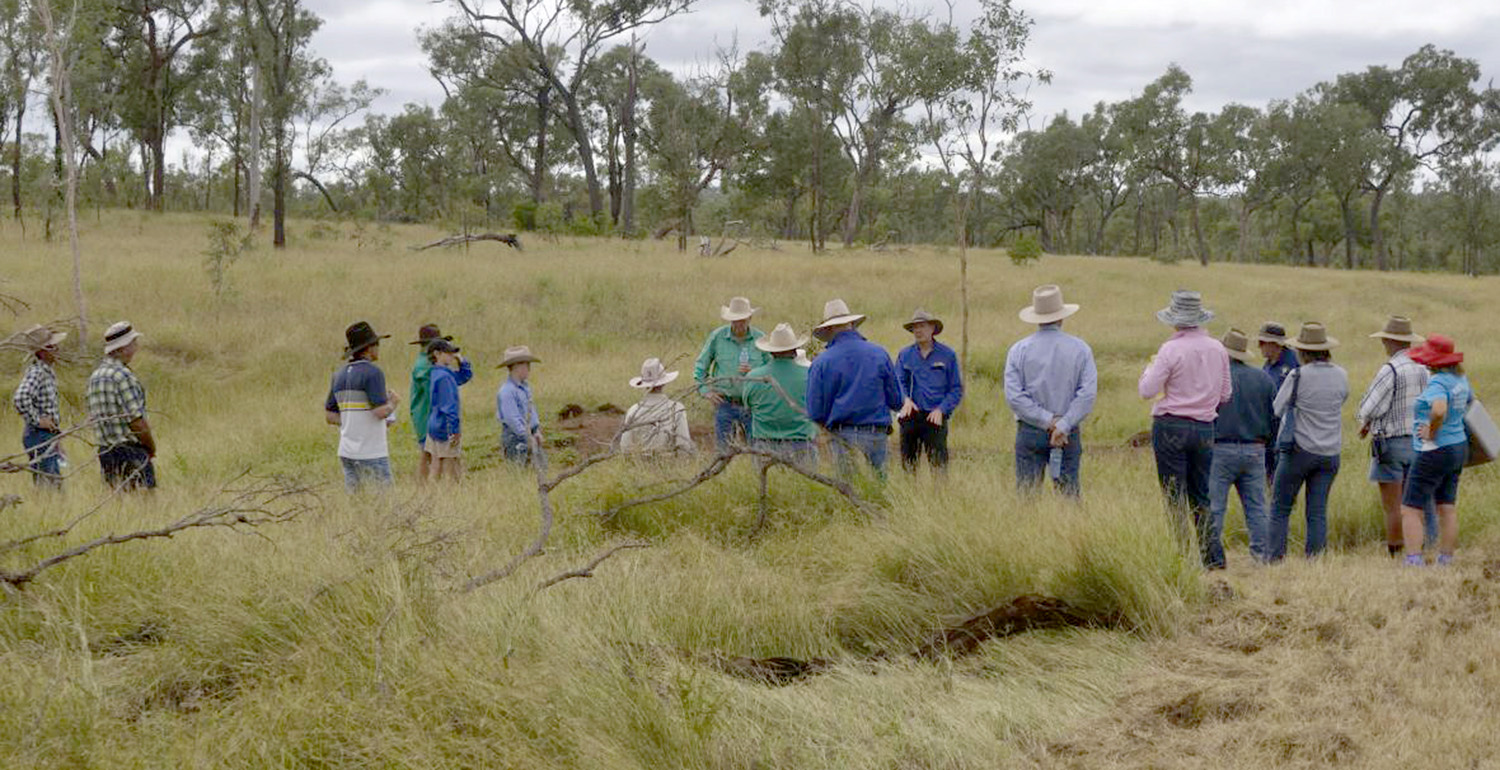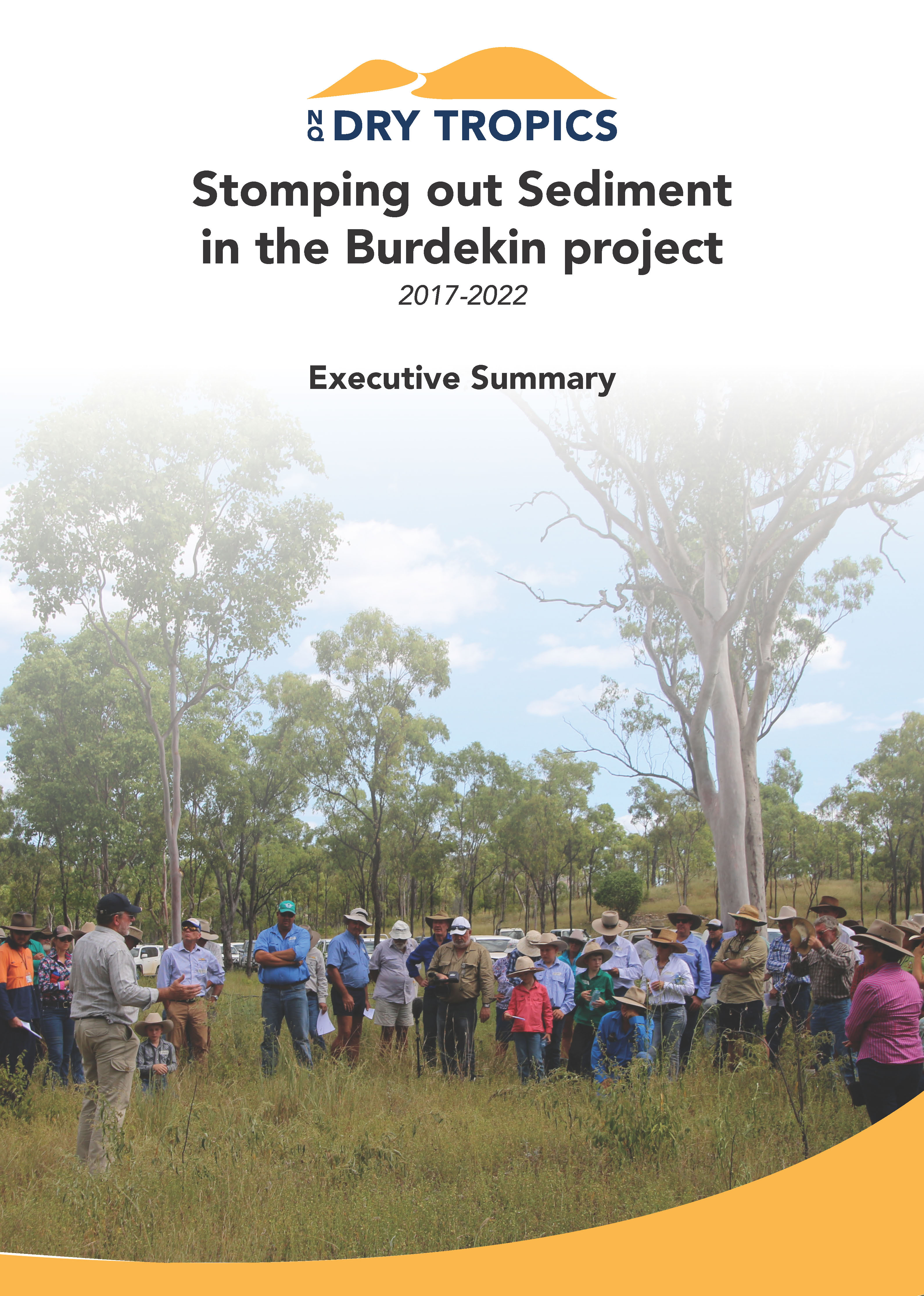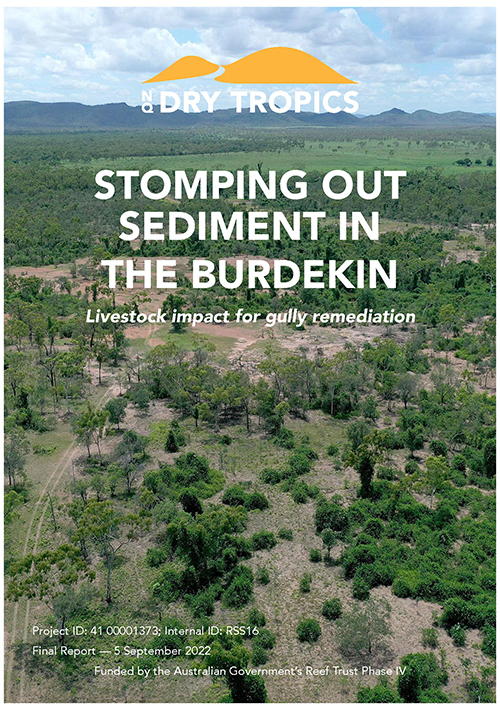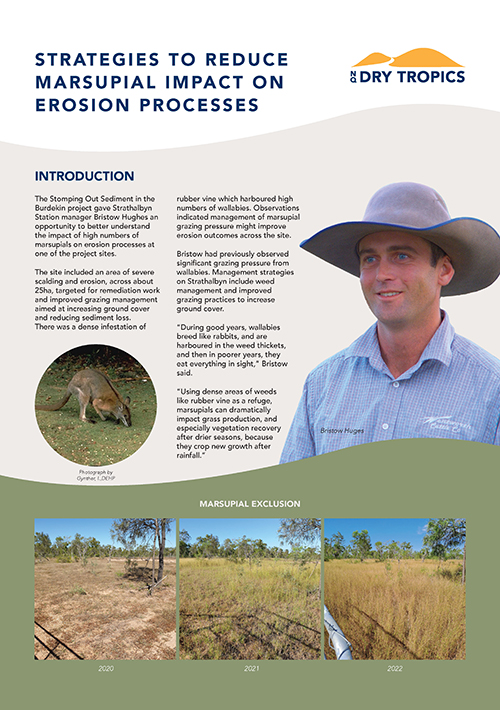Stomping Out Sediment in the Burdekin
(June 2017 – June 2023)
At a glance
- 17 project sites across 9 properties;
- 29 one-on-one extension sessions;
- 17 field days attended by 310 people;
- 12 partners and service providers and 6 local contractors helped deliver the project;
- 4 organisations collaborated to form the monitoring team;
- $377,000 in-kind support;
- 1,857tonnes reduction in sediment from treated sites each year.
At a glance
- 17 project sites across 9 properties;
- 29 one-on-one extension sessions;
- 17 field days attended by 310 people;
- 12 partners and service providers and 6 local contractors helped deliver the project;
- 4 organisations collaborated to form the monitoring team;
- $377,000 in-kind support;
- 1,857tonnes reduction in sediment from treated sites each year.
Stomping Out Sediment project manager Rod Kerr speaks during a Dick Richardson Grazing Naturally workshop.
Unconventional approach to gully management
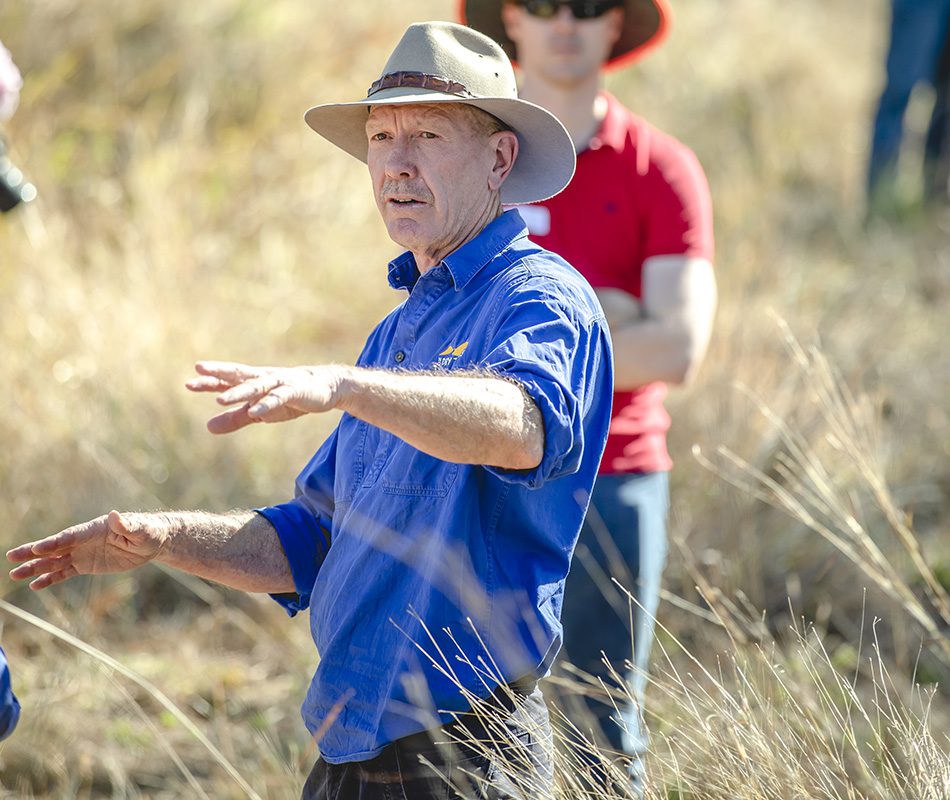
The Stomping out Sediment in the Burdekin project took an unconventional approach to gully management, testing and evaluating the use of livestock as a tool to remediate gullies, as well as implementing more conventional gully remediation approaches.
The six-year project (2017-2023) was conducted at 17 sites across nine properties.
The project sites generally had poor land condition — D or C land condition — with loss of native pasture species, reduced biomass production, even on more productive black soils, and were dominated by Indian couch (Bothriochloa pertusa).
Treatments at sites included:
- livestock exclusion;
- planned grazing practices, which included:
- “regenerative” or rotational grazing practices on project paddocks;
- planned, higher density, rotational grazing (for example, 3000 weaners on 60-100ha paddocks for 2-3 days);
- ultra high density livestock treatments (for example, 1100 head on 8ha for 24hrs on a black soil site);
- biological carpeting (for example, overnight or a day camping a large number of livestock on a small area such as 800 head on a 1ha alluvial gully site);
- management of livestock grazing in contributing gully catchments through fencing and water point distribution:
- 22km of permanent conventional fencing;
- 10km of permanent electric fencing;
- 5 water tanks;
- 11km of piping;
- 15 troughs;
- the construction of earthworks and other interventions such as diversion banks, water spreading banks and whoa-boys, reshaping of gully features, sub-catchment ripping and reseeding, and construction of porous check dams; and
- full remediation of some erosion features such as the construction of three rock chutes, reshaping and capping, and soil amelioration of severely-eroded sites such as the alluvial gully site at Strathalbyn and the gully complex at Johnnycake.
A number of project sites were focused on more productive soils such as black cracking clay soil sites at three of the nine properties.
Weed management activities were carried out on black cracking clay soils at two sites.
All other project sites were implemented on less productive soil types, often with fertility, structural or chemical constraints, with the more extreme examples being an alluvial gully, part of a large gully complex with severe, deep erosion and tunnelling features and another on a gully complex.
A range of monitoring techniques were used based on the Gully and Streambank Toolbox, a technical guide for gully and stream bank erosion control programs in Great Barrier Reef catchments.
These included photo monitoring, land condition assessment, remote sensing and analysis, and high resolution LiDAR, Griffith University completed the high resolution LiDAR analyses, University of Southern Queensland undertook soils analyses, and CSIRO analysed Patchkey data.
Sediment savings from all sites is 1,857 tonnes per annum.
Total project expenditure was $2,125,000 plus in-kind contributions from other programs, staff time and resources, and grazier cash and in-kind contributions totalling $377,000.
The project delivered significant activity in the Bowen and Collinsville regional economy including expenditure on construction materials, infrastructure materials, vehicle hire, accommodation and catering, equipment hire, the provision of services by local contractors including fencing contractors, and earthworks construction and maintenance.
Australian Rangeland Society Conference
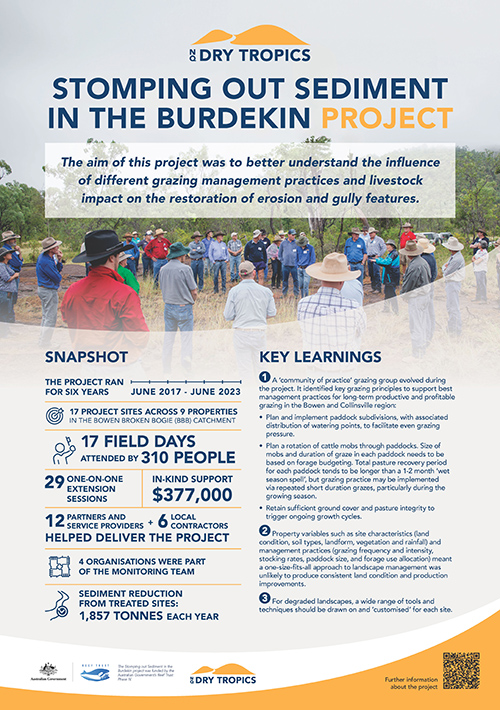 Project Manager Rod Kerr and Glenalpine grazier Barry O’Sullivan presented an outline of the Stomping Out Sediment in the Burdekin project at the 22nd annual Australian Rangeland Society Conference in Broome.
Project Manager Rod Kerr and Glenalpine grazier Barry O’Sullivan presented an outline of the Stomping Out Sediment in the Burdekin project at the 22nd annual Australian Rangeland Society Conference in Broome.
Barry and wife Leanne were involved in the project from the beginning and have been proactive in testing different methods of using cattle to help heal country.
Unconventional approach to gully management

The Stomping out Sediment in the Burdekin project took an unconventional approach to gully management, testing and evaluating the use of livestock as a tool to remediate gullies, as well as implementing more conventional gully remediation approaches.
The five-year project (2017-2023) was conducted at 16 sites across nine properties.
The project sites generally had poor land condition — D or C land condition — with loss of native pasture species, reduced biomass production, even on more productive black soils, and were dominated by Indian couch (Bothriochloa pertusa).
Treatments at sites included:
- livestock exclusion;
- planned grazing practices, which included:
- “regenerative” or rotational grazing practices on project paddocks;
- planned, higher density, rotational grazing (for example, 3000 weaners on 60-100ha paddocks for 2-3 days);
- ultra high density livestock treatments (for example, 1100 head on 8ha for 24hrs on a black soil site);
- biological carpeting (for example, overnight or a day camping a large number of livestock on a small area such as 800 head on a 1ha alluvial gully site);
- management of livestock grazing in contributing gully catchments through fencing and water point distribution:
- 22km of permanent conventional fencing;
- 10km of permanent electric fencing;
- 5 water tanks;
- 11km of piping;
- 15 troughs;
- the construction of earthworks and other interventions such as diversion banks, water spreading banks and whoa-boys, reshaping of gully features, sub-catchment ripping and reseeding, and construction of porous check dams; and
- full remediation of some erosion features such as the construction of three rock chutes, reshaping and capping, and soil amelioration of severely-eroded sites such as the alluvial gully site at Strathalbyn and the gully complex at Johnnycake.
A number of project sites were focused on more productive soils such as black cracking clay soil sites at three of the nine properties.
Weed management activities were carried out on black cracking clay soils at two sites.
All other project sites were implemented on less productive soil types, often with fertility, structural or chemical constraints, with the more extreme examples being an alluvial gully, part of a large gully complex with severe, deep erosion and tunnelling features and another on a gully complex.
A range of monitoring techniques were used based on the Gully and Streambank Toolbox, a technical guide for gully and stream bank erosion control programs in Great Barrier Reef catchments.
These included photo monitoring, land condition assessment, remote sensing and analysis, and high resolution LiDAR, Griffith University completed the high resolution LiDAR analyses, University of Southern Queensland undertook soils analyses, and CSIRO analysed Patchkey data.
Sediment savings from all sites is 1,857 tonnes per annum.
Total project expenditure was $2,125,000 plus in-kind contributions from other programs, staff time and resources, and grazier cash and in-kind contributions totalling $377,000.
The project delivered significant activity in the Bowen and Collinsville regional economy including expenditure on construction materials, infrastructure materials, vehicle hire, accommodation and catering, equipment hire, the provision of services by local contractors including fencing contractors, and earthworks construction and maintenance.
Australian Rangeland Society Conference
 Project Manager Rod Kerr and Glenalpine grazier Barry O’Sullivan will present an outline of the Stomping Out Sediment in the Burdekin project at the 22nd annual Australian Rangeland Society Conference.
Project Manager Rod Kerr and Glenalpine grazier Barry O’Sullivan will present an outline of the Stomping Out Sediment in the Burdekin project at the 22nd annual Australian Rangeland Society Conference.
Barry and wife Leanne were involved in the project from the beginning and have been proactive in testing different methods of using cattle to help heal country.
RESOURCES
MLA war on weeds
Meat and Livestock Australia, in partnership with NQ Dry Tropics developed a Producer Demonstration Site designed to showcase what could be achieved in the war on weeds when properties joined forces to tackle the problem in a cooperative and integrated way.
The group of six properties around Collinsville and Bowen conducted weed management trials and shared the results through case studies. Click on the image of the cover, (below), to open each one.
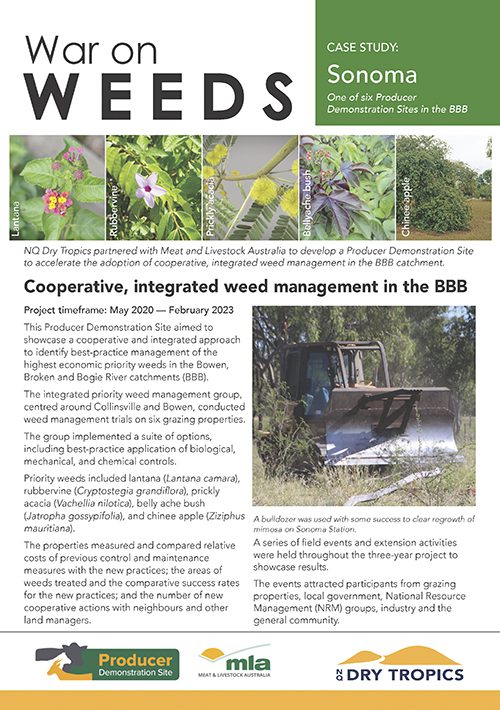 |
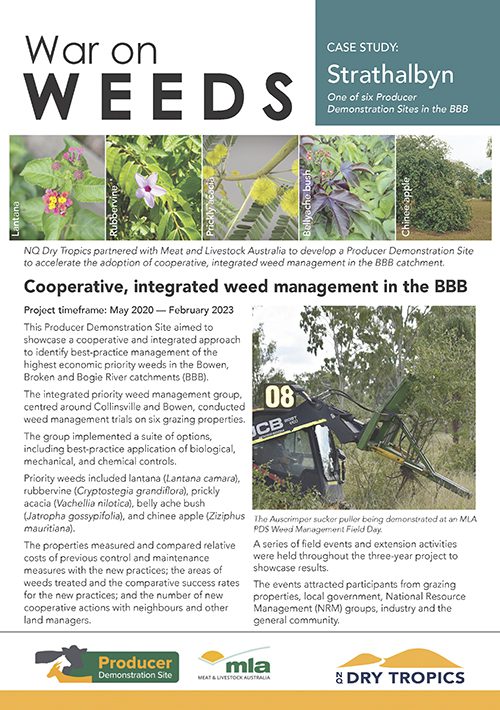 |
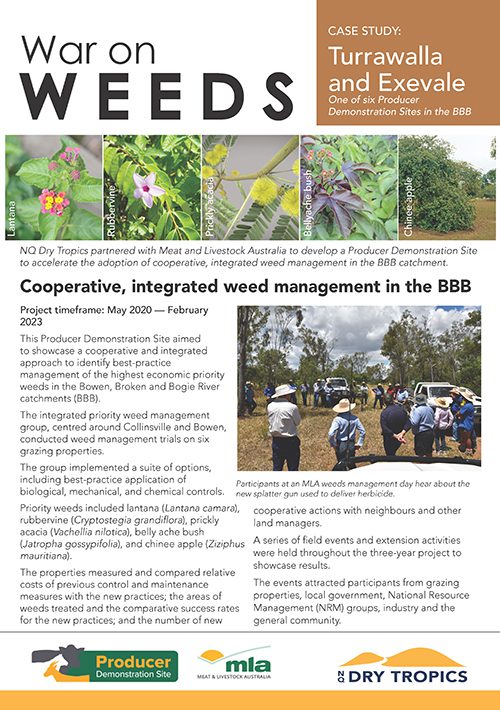 |
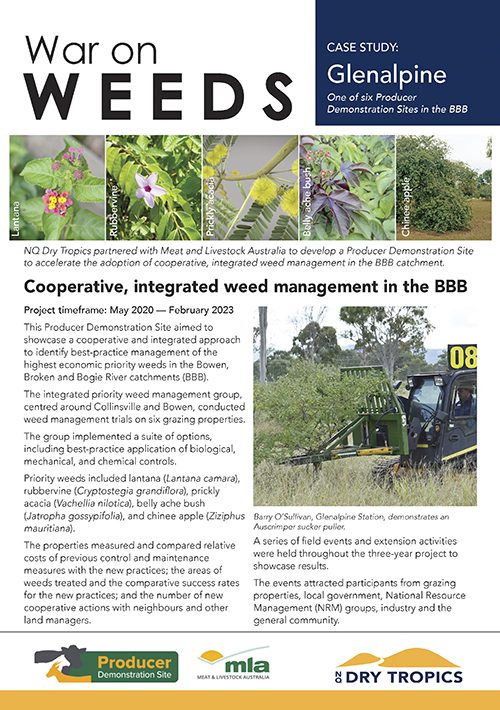 |
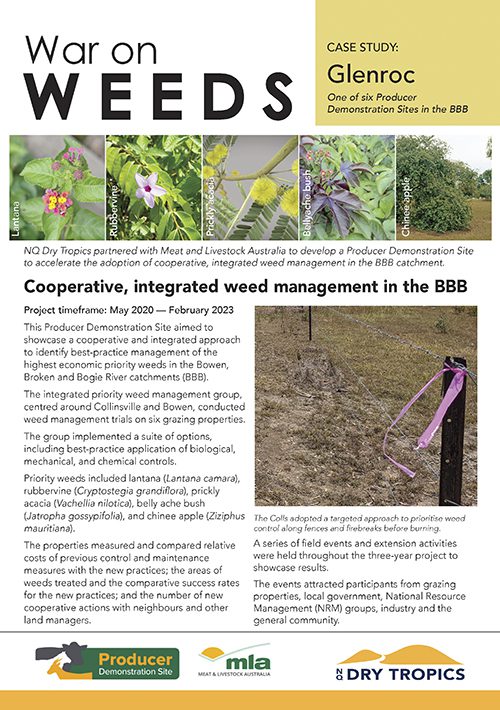 |
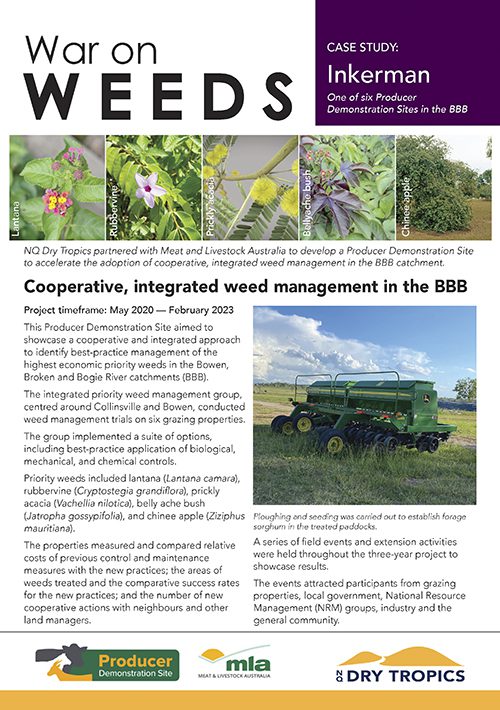 |
Glenalpine Station |
Strathalbyn Station |
Hellsgate Station |
|

